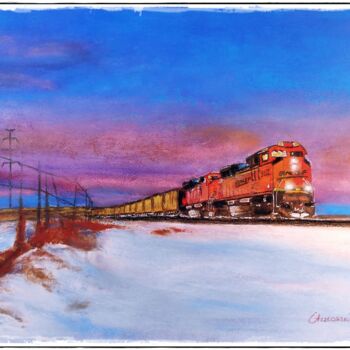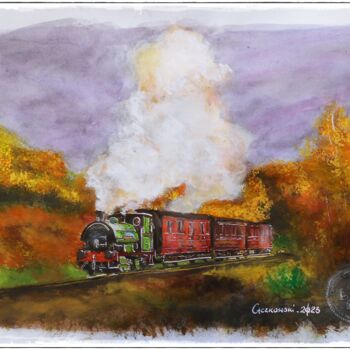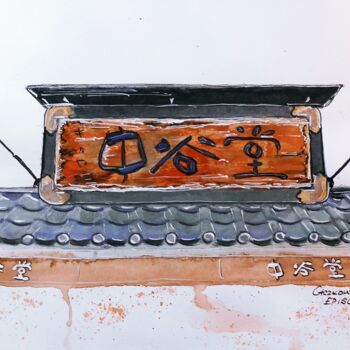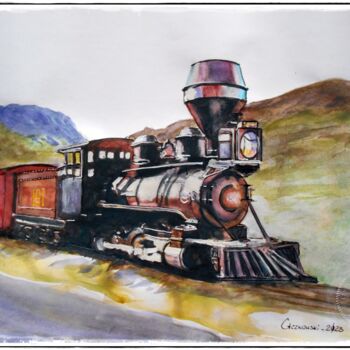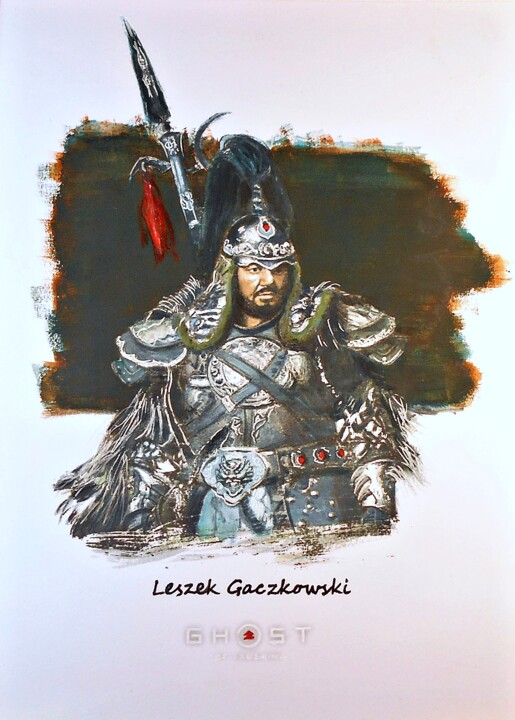
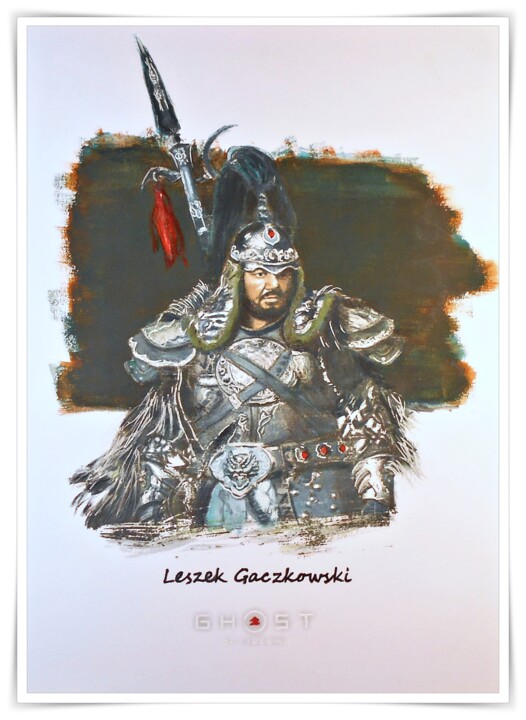
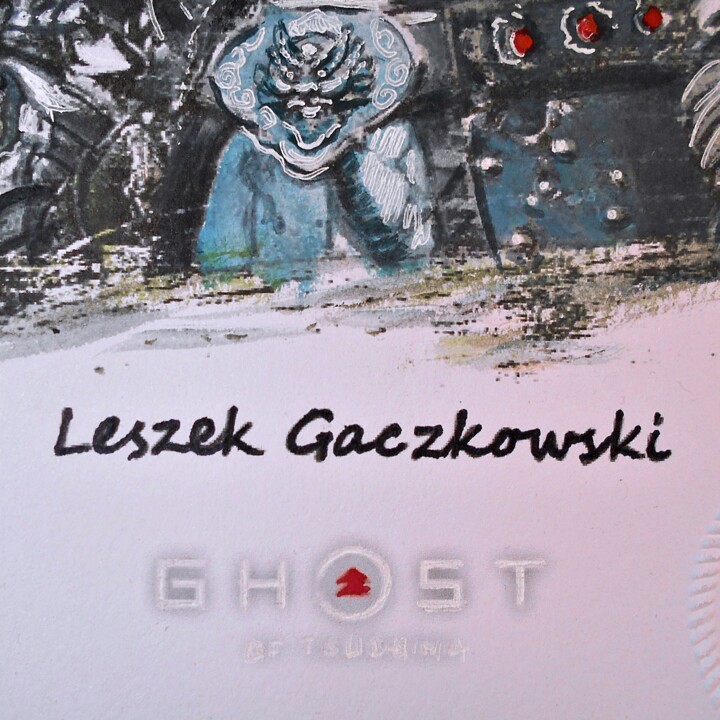
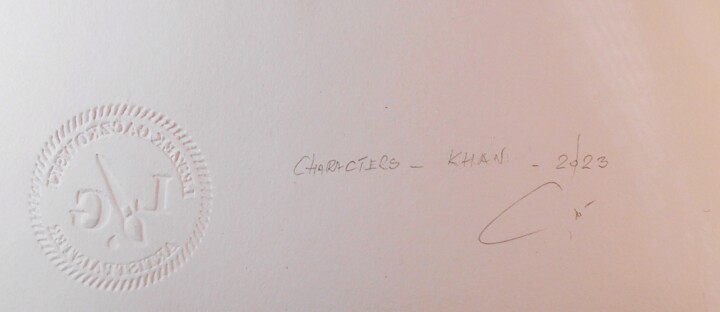


Fateci sapere se volete vedere altre foto di questa opera d'arte!
- Retro del lavoro / Lato del lavoro
- Dettagli / Firma / Superficie o struttura dell'opera d'arte
- Opera d'arte in situazione, Altro...
GHOST OF TSUSHIMA 002 / 23 - CHARACTERS - Khan - (2023) (2023) Pittura da Leszek Gaczkowski
Maggiori informazioni
- Confezione (Imballaggio in scatola o cartone) Tutte le opere sono spedite con cura protetta e assicurata, con un vettore premium.
- Controllo Controlla il tuo ordine fino alla consegna al compratore. Verrà fornito un numero di tracking per seguire la spedizione in tempo reale.
- Scadenza La maggior parte dei pacchi viene consegnata in tutto il mondo entro 1-3 settimane (Stima)
- Dogana non inclusa Il prezzo non include le tasse doganali. La maggior parte dei paesi non ha tasse di importazione per le opere d'arte originali, ma potresti dover pagare l'IVA ridotta. Le tasse doganali (se presenti) devono essere calcolate all'arrivo dall'ufficio doganale e saranno fatturate separatamente dal vettore.
Maggiori informazioni
- Certificato di autenticità online tracciabile I certificati di autenticità possono essere verificati online in qualsiasi momento scansionando il codice dell'opera d'arte.
- Certificato di quotazione d'artista Gli esperti studiano il lavoro e la carriera di un artista. In seguito stabiliscono un valore medio, in modo indipendente e affidabile, del prezzo. Il valore medio dei prezzi colloca l'artista in una fascia di prezzo per un determinato periodo. Gli esperti possono essere invitati a stabilire una stima più precisa per un'opera in particolare.
Maggiori informazioni
Pagamento sicuro al 100% con certificato SSL + 3D Secure.
Maggiori informazioni
Questa stampa è disponibile in diverse dimensioni.
Venduto da Leszek Gaczkowski
Quest'immagine è disponibile per lo scaricamento con una licenza.
Venduto da Leszek Gaczkowski
-
Opera d'arte originale (One Of A Kind)
Pittura,
Gouache
su Carta
- Dimensioni Altezza 11,7in, Larghezza 8,3in
- Condizioni dell'opera d'arte L'opera d'arte è in perfette condizioni
- Incorniciatura Questa opera d'arte non è incorniciata
- Categorie Quadri sotto i 500 USD Arte concettuale Video gioco
Khotun Khan is a cousin of Kublai Khan and grandson of Genghis Khan. He grew up to be a very successful and well-known General in the Mongol Empire. But he originally grew up in China. Shortly before the Goryeo campaign, he released his favorite golden eagle, nicknamed Little Brother. Following the conquest of Goryeo, Khotun was engaged in a conquest of Japan. The Khan was eagerly ambitious, and if he was successful, he would not only spread his name but would be able to vie for the title of Great Khan himself. Before leading the invasion, Khotun learned the Japanese language and used spies and informants to learn about Japan's history, politics, and culture.
Khotun began his conquest of Japan by invading the island of Tsushima. Khotun set out for Tsushima with a large invasion force consisting of thousands of Mongols, including of one his best generals, Temuge, aboard a massive Mongol fleet that he intends to use to blockade the island.
The Khan and the Mongols made landfall at Komoda Beach, where they became involved in a standoff with the island's samurais, led by Shimura. and his nephew Sakai, Harunobu Adachi attempts to challenge the Khan to single combat, and he replies by lighting the Samurai on fire and beheading him, an act that knowingly insults the samurai code of bushido. This enraged Shimura into ordering a frontal charge, resulting in the decimation of the Samurai. Knowing that the jito is more valuable alive, Khotun captures him alive and reveals his identity to him, explaining how he had prepared for this invasion. The Khan knocks Shimura out when he silently refuses to surrender and takes him to Castle Kaneda. The castle is soon attacked by Lord Shimura's nephew Jin Sakai, who fights his way through the Mongols to rescue his uncle and confronts the Khan on the Castle's bridge. Jin challenges the Khan to single combat but is swiftly defeated. Khotun asks Jin to surrender, but when his face is cut by Jin, the Khan throws Jin from the bridge to the waters below.
Meanwhile, the Khan's forces advance across the isle, pillaging and destroying many settlements, temples, and garrisons and setting up camps and strongholds along the way. During this time, Khotun engages in frequent conversations with a local monk, Daizo, who seeks to document his words and deeds in order to foster mutual understanding and prevent more bloodshed, partially out of eagerness to learn more about Japanese culture and history. Khotun confides in the monk that he plans to convince Shimura to join the Mongol cause, and offer to make him Shogun and let him rule Japan as Khotun's right-hand man, as well as aiding Khotun in overthrowing Kublai.
Khotun makes several attempts to convince Shimura to join his cause, counting on Shimura's over-reliance on the traditions of the samurai. Shimura is unwilling to speak to the Khan until he learns that Jin survived the earlier confrontation with Khotun. Noting the love that Shimura has for his nephew, Khotun asks the jito if he will abandon his children to their savage demises at the hands of the Mongols, noting that surrendering could ensure their safety. Shimura responds that he and Lord Sakai will fight until their last breath. The next time Khotun visits the imprisoned Jito, he gives him an update on Jin's activities: his men have found their brothers stabbed in the back, a direct violation of the Samurai honor code, which Shimura had used to enforce the belief that Samurai and Mongols are different.
Shimura is in disbelief at Khotun's words, and he points out that war brings out the worst in all men. Khotun attempts to appeal to Shimura's fear that his nephew will become what he hates unless he joins his empire's fight for peace. Shimura counters that the Khan does not really want allies, but soldiers to overthrow the Shogun, and continues to refuse. Khotun leaves, though not before warning the ji that it is only a matter of time before it is too late for Jin and before he brings Shimura Jin's head. Khotun later makes one more visit to Shimura and informs him that Jin's dishonorable activities have increased to the point where he tears Mongols apart like a beast.
Shimura dismisses this by saying he's sure Khotun has done worse, leading Khotun to realize that Shimura still believes that they are different. Khotun argues that they fight for the same thing: a legacy that outlives them, which is in danger of falling apart thanks to his nephew becoming astray. Shimura counters that he won his legacy with duty and honor, by restoring order to his home, while firmly refusing Khotun's offer. Not regarding Shimura's cooperation as crucial to his designs for the mainland, he informs the jito that he is going to conquer his ancestral home, Castle Shimura, and leaves him to starve in this cell, alone and without honor.
In addition, Khotun receives word that Ryuzo and his Straw Hat Ronin are starving and have allied with Jin out of desperation. Khotun has his men treat some Straw Hat captives politely and is later able to bribe Ryuzo and the Straw Hats to join the Mongols against their own people, winning them over due to the Straw Hats' desperate need for supplies, as well as instilling the notion that the Mongols will win the war against the Japanese. When Jin launches his assault on Castle Kaneda to rescue his uncle, Khotun offers to give Ryuzo immediate food for his men if he is able to stop Jin. He fails, and Jin rescues his uncle and takes Castle Kaneda from the Mongols.
Displeased by Ryuzo's failure, Khotun withholds the food for his men and takes Ryuzo with him to conquer Castle Shimura. To atone for Castle Kaneda's loss, the Khan forces Ryuzo to burn a captive peasant alive outside Shimura Castle, coercing them into opening the gates and surrendering to the Mongols.[2] Khotun continues his conversations with Daizo inside Castle Shimura, which he explains is strategically more important than Castle Kaneda because it shields his forces in the frozen wilds of the north. Khotun is confident that his enemies will exhaust themselves fighting each other and the Mongols, and stock up on food, munitions, and supplies, intending to depart for the mainland when the time is right.
During this time, Khotun offers the eagle a deal to try to break Jin and make him into the killer Kouthan wants him to be he becomes increasingly fascinated with Jin after hearing about the Eagle's death at the hands of Jin who has half the island believing that he is a vengeful Samurai spirit. This belief increases after Jin kills kouthans right-hand man Temuge with the fearsome Ghost Stance, causing Khotun's men to believe that Jin, now known as the Ghost of Tsushima, is an invincible foe. Khotun sees an opportunity to divide the people, who adore the Ghost, from Lord Shimura and the other samurai. Following Temuge's death, Khotun decides that the Ghost has become too much of a problem and orders Ryuzo to put an end to him. However, Ryuzo convinces the Khan to give Jin a second chance. He lures Jin into a trap and captures him, along with his friend Taka, and leaves them tied to poles.
Khotun arrives not long afterward to meet with Jin once again. He points out how he and Jin are both survivors and draws comparisons to both of them, such as how live under the shadows of their elders; in Khotun's case, living up to his grandfather. He asks why they should settle for scraps when they have done enough to be legends. Khotun offers Jin amnesty if he surrenders and convinces his people to join the Mongols, reasoning that he could do it because of how much they admire him, but Jin refuses. Angered, Khotun unties Taka and hands him a katana, ordering him to kill Jin in exchange for his freedom. Taka attempts to attack Khotun, but Khotun easily subdues the blacksmith and beheads him to the horror of Jin. Khotun then leaves, intending to "find another" and make Jin choose again. Jin, however, manages to escape, swearing vengeance on the Khan and his allies.
Later on, as Jin and Lord Shimura prepare to launch an attack on Castle Shimura, Khotun speaks to Ryuzo and tells him that the Samurai's honor code makes them easy to break. However, the Ghost has become unpredictable, and this makes him dangerous. The ensuing siege sees the Khan's forces pushed into the inner keep. Shimura then orders a frontal charge, but Khotun anticipates this and sends out horse chariots filled with explosives, which detonate, causing massive casualties to the samurai. This action causes Khotun's attempts to divide the Ghost and the Jito to come to a climax. More infuriated than ever at the Khan for his killing of Taka, Jin's desire to resort to dishonorable tactics led him to cut ties with Lord Shimura.
He and Taka's vengeful older sister, Yuna, use piles of Wolfsbane flowers to create a poison. Jin subsequently infiltrates Castle Shimura and sneaks poison into the Mongols' food, killing them all. Jin also kills Ryuzo in a duel, resulting in the castle being successfully taken. Khotun, however, has already left to meet with his soldiers in the frozen wilds up north. Khotun later learns that the poison of Wolfsbane flowers was used by Jin to massacre his soldiers, and orders his men to gather massive amounts of the deadly flower. The Khan uses the poison to devastate the Kamiagata region, much to the disapproval of Daizo, and retreats to his base of operations in Izumi Harbor.
At this point, Khotun intends to sail for the mainland, content that Shimura and his reinforcements from the Shogun do not have the strength nor numbers to alter his plans, as Tsushima was only ever a place to resupply and prepare for the invasion of the mainland. Aware of the divisions between the emperor's court at Kyoto and the seat of the shogunate, Khotun intends to utilize Jin's poison against the mainland, ensuring a brutal conquest. He was unaware that Yuna, who had taken over for Jin after he was arrested by Shimura's men for his dishonorable tactics, had tracked him down to his base. She later arranged for Jin to escape the prison and meet her up north. They plotted a final attack on the Khan before he could flee the mainland, calling upon their allies, along with the assistance of Lord Shimura and the forces of the Shogun.
The battle of Port Izumi begins soon after, with the people of Tsushima gaining the upper hand after Lord Shimura's forces arrive. After locating the Khan from a watchtower, Jin confronts Khotun on a frozen lake. The Khan chastises him for not accepting Mongol rule, claiming all the deaths could have been avoided had Jin submitted, and declared that the people of his mainland would suffer. Vowing that Khotun would never leave the island, Jin engages him in a fierce duel. Khotun is confident in his chances, believing that it is not his destiny to die here and that their duel will be no different from the first. Jin, however, has learned many techniques and forms since their first encounter and overpowers the Khan.
Realizing that he cannot defeat the Ghost alone, Khotun flees to his flagship and calls for the assistance of his soldiers. Despite the help of his reinforcements, Khotun is overpowered by Jin, who shatters his spear, defeats his reinforcements, and disarms him of his sword and shield. Jin then impales Khotun with his sword, pinning him to a wooden beam on the boat. Khotun declares how he will forever be remembered, and one day someone will come and finish what he started but Jin mocks him in disgust saying "No you will be forgotten" Jin then removes his sword from Khotun's chest, causing him to fall forward onto his sword, which decapitated him.
The death of Khotun Khan cripples the Mongol invasion, sparing mainland Japan from the Mongol forces, and causing the bulk of the Khan's army to retreat back across the sea. Despite the Khan's death, many of his forces remained in Tsushima, continuing their fight against Jin and his allies.
Temi correlati
GouacheGouache On PaperOriginal PaintingGhost Of TsushimaKhan
Leszek Gaczkowski è nato e vive in Slesia, in Polonia. Ha ricevuto un'istruzione tecnica anche se fin dalla tenera età ha mostrato un forte interesse per la musica e le arti. Suona anche la chitarra. Tuttavia ha rinunciato alla sua passione per seguire una strada diversa, e ora ci sta tornando. Crede che la pittura o qualsiasi altra forma d'arte sia un'illustrazione delle sue idee. Esprime i suoi sentimenti, le sue capacità naturali e lo sforzo spesso associato alla gioia di creare. Le sue opere d'arte, compresi i dipinti, sono di proprietà non solo delle sue capacità naturali, per le quali è enormemente grato, ma sono anche l'effetto dell'auto-studio, dell'auto-miglioramento e soprattutto del duro lavoro! Le sue tecniche preferite sono i pastelli, i colori ad olio e gli acquerelli, ma non si discosta nemmeno dal carboncino, dal seppia e dalla sanguigna. I pastelli sono strumenti molto delicati perfetti per esprimere dettagli sfuggenti come le espressioni facciali che ultimamente sono diventate una delle sue attività preferite. Si è concentrato sulla cattura di sentimenti ed emozioni producendo il suo stile originale. Tra le sue opere possiamo trovare sia volti iconici e noti di quelli noti a tutti, sia quelli che appartengono a persone anonime che ha incontrato sulla sua strada e che lo hanno ispirato. Sebbene si sia dedicato all'arte del ritratto, non si è mai limitato a questo ramo. Come artista versatile, era sempre alla ricerca di nuove sfide e ispirazioni. Questo gli ha fatto scoprire la sua grande passione per la pittura di paesaggi e lo ha reso molto abile nelle tecniche dell'acquerello dure e impegnative ma attente. All'interno del suo stile unico, molte delle sue opere d'arte si legano a quelle dei grandi impressionisti che crea i suoi dipinti, ma reinterpreta anche dipinti già esistenti. Espone le sue opere nelle più note gallerie d'arte che sono associate a molti artisti in Polonia. Alcuni dei suoi dipinti sono anche sugli appalti. Ora sono decorati, in case di collezionisti privati in paesi come Inghilterra, Francia, Spagna, Germania, Repubblica Ceca, Belgio, Italia, Portogallo, Taiwan, Paesi Bassi, Svizzera, Bahrain e Polonia. Questa passione per la pittura attiva risale al 2010. È molto aperto a suggerimenti e ispirazioni e condivide volentieri le sue esperienze con gli altri.
-
Nazionalità:
POLONIA

- Data di nascita : 1953
- Domini artistici:
- Gruppi: Artisti Polacchi Contemporanei










